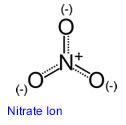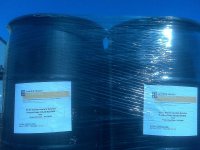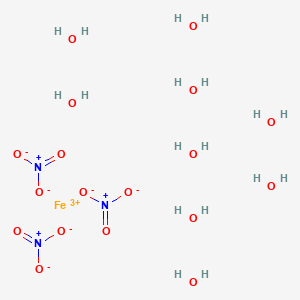SECTION 1. IDENTIFICATION
Product Name: Iron Nitrate Solution
Product Number: All applicable American Elements product codes, e.g. FE-NAT-02-SOL
, FE-NAT-03-SOL
, FE-NAT-04-SOL
, FE-NAT-05-SOL
CAS #: 7782-61-8
Relevant identified uses of the substance: Scientific research and development
Supplier details:
American Elements
10884 Weyburn Ave.
Los Angeles, CA 90024
Tel: +1 310-208-0551
Fax: +1 310-208-0351
Emergency telephone number:
Domestic, North America: +1 800-424-9300
International: +1 703-527-3887
SECTION 2. HAZARDS IDENTIFICATION
Appearance: not available liquid.
Danger! Strong oxidizer. Contact with other material may cause a fire. May cause severe eye and skin irritation with possible burns. May cause severe respiratory and digestive tract irritation with possible burns. May cause methemoglobinemia. May cause liver and kidney damage.
Target Organs: Blood, kidneys, central nervous system, liver.
Potential Health Effects
Eye: Contact with eyes may cause severe irritation, and possible eye burns. May cause conjunctivitis. May cause permanent corneal opacification.
Skin: May cause severe irritation and possible burns.
Ingestion: May cause gastrointestinal irritation with nausea, vomiting and diarrhea. May cause methemoglobinemia, cyanosis (bluish discoloration of skin due to deficient oxygenation of the blood), convulsions, and death. May cause systemic toxic effects on the heart, liver, and kidneys. May cause severe digestive tract irritation with abdominal pain, nausea, vomiting and diarrhea.
Inhalation: May cause methemoglobinemia, cyanosis (bluish discoloration of skin due to deficient oxygenation of the blood), convulsions, tachycardia, dyspnea (labored breathing), and death. May cause effects similar to those described for ingestion. This product contains nitrite which may cause methemoglobinemia. May cause acute pulmonary edema, asphyxia, chemical pneumonitis, and upper airway obstruction caused by edema.
Chronic: May cause methemoglobinemia, which is characterized by chocolate-brown colored blood, headache, weakness, dizziness, breath shortness, cyanosis (bluish skin due to deficient oxygenation of blood), rapid heart rate, unconsciousness and possible death. Effects may be delayed.
SECTION 3. COMPOSITION/INFORMATION ON INGREDIENTS
CAS: 7732-18-5
Chemical Name: Water
Percent: 60
EINECS: 231-791-2
CAS: 7782-61-8
Chemical Name: Ferric Nitrate Nonahydrate
Percent: 40
EINECS: unlisted
SECTION 4. FIRST AID MEASURES
Eyes: Immediately flush eyes with plenty of water for at least 15 minutes, occasionally lifting the upper and lower eyelids. Get medical aid immediately.
Skin: Get medical aid. Immediately flush skin with plenty of water for at least 15 minutes while removing contaminated clothing and shoes. Wash clothing before reuse.
Ingestion: Do not induce vomiting. If victim is conscious and alert, give 2-4 cupfuls of milk or water. Never give anything by mouth to an unconscious person. Get medical aid immediately.
Inhalation: Get medical aid immediately. Remove from exposure and move to fresh air immediately. If not breathing, give artificial respiration. If breathing is difficult, give oxygen. Do NOT use mouth-to-mouth resuscitation.
Notes to Physician: For methemoglobinemia, administer oxygen alone or with Methylene Blue depending on the methemoglobin concentration in the blood.
Antidote: The use of Deferoxamine as a chelating agent should be determined only by qualified medical personnel. Methylene blue, alone or in combination with oxygen is indicated as a treatment in nitrite induced methemoglobinemia.
SECTION 5. FIREFIGHTING MEASURES
General Information: As in any fire, wear a self-contained breathing apparatus in pressure-demand, MSHA/NIOSH (approved or equivalent), and full protective gear. Strong oxidizer. Contact with other material may cause fire. During a fire, irritating and highly toxic gases may be generated by thermal decomposition or combustion. Use water spray to keep fire-exposed containers cool. Use water with caution and in flooding amounts. Some oxidizers may react explosively with hydrocarbons(fuel). May accelerate burning if involved in a fire. Causes violent reactions when in contact with metals. Non-combustible, substance itself does not burn but may decompose upon heating to produce irritating, corrosive and/or toxic fumes.
Extinguishing Media: Substance is noncombustible; use agent most appropriate to extinguish surrounding fire. Contact professional fire-fighters immediately. Cool containers with flooding quantities of water until well after fire is out. For small fires, do NOT use dry chemicals, carbon dioxide, halon or foams. USE WATER ONLY. For large fires flood fire with water from a distance.
Flash Point: N/A.
Autoignition Temperature: N/A.
Explosion Limits, Lower:Not available.
Upper: Not available.
NFPA Rating: (estimated) Health: 2; Flammability: 0; Instability: 1; Special Hazard: OX
SECTION 6. ACCIDENTAL RELEASE MEASURES
General Information: Use proper personal protective equipment as indicated in Section 8.
Spills/Leaks: Absorb spill with inert material (e.g. vermiculite, sand or earth), then place in suitable container. Avoid runoff into storm sewers and ditches which lead to waterways. Clean up spills immediately, observing precautions in the Protective Equipment section. Remove all sources of ignition. Provide ventilation. Do not use combustible materials such as paper towels to clean up spill.
SECTION 7. HANDLING AND STORAGE
Handling: Wash thoroughly after handling. Remove contaminated clothing and wash before reuse. Use with adequate ventilation. Avoid contact with eyes, skin, and clothing. Keep container tightly closed. Avoid contact with clothing and other combustible materials. Avoid ingestion and inhalation. Keep from contact with clothing and other combustible materials.
Storage: Keep away from heat, sparks, and flame. Do not store near combustible materials. Store in a cool place in the original container and protect from sunlight. Store in a tightly closed container.
SECTION 8. EXPOSURE CONTROLS/PERSONAL PROTECTION
Engineering Controls: Facilities storing or utilizing this material should be equipped with an eyewash facility and a safety shower. Use adequate ventilation to keep airborne concentrations low.
Chemical Name: Water
ACGIH: none listed
NIOSH: none listed
OSHA - Final PELs: none listed
Chemical Name: Ferric Nitrate Nonahydrate
ACGIH: 1 mg/m3 TWA (as Fe) (listed under Iron salts (soluble)).
NIOSH: 1 mg/m3 TWA (as Fe) (listed under Iron salts (soluble)).
OSHA - Final PELs: none listed
OSHA Vacated PELs: Water: No OSHA Vacated PELs are listed for this chemical. Ferric Nitrate Nonahydrate: No OSHA Vacated PELs are listed for this chemical.
Personal Protective Equipment
Eyes: Wear appropriate protective eyeglasses or chemical safety goggles as described by OSHA's eye and face protection regulations in 29 CFR 1910.133 or European Standard EN166.
Skin: Wear appropriate gloves to prevent skin exposure.
Clothing: Wear a chemical apron. Wear appropriate clothing to prevent skin exposure.
Respirators: Follow the OSHA respirator regulations found in 29 CFR 1910.134 or European Standard EN 149. Use a NIOSH/MSHA or European Standard EN 149 approved respirator if exposure limits are exceeded or if irritation or other symptoms are experienced.
SECTION 9. PHYSICAL AND CHEMICAL PROPERTIES
Physical State: Liquid
Appearance: not available
Odor: none reported
pH: Not available.
Vapor Pressure: Not available.
Vapor Density: Not available.
Evaporation Rate:Not available.
Viscosity: Not available.
Boiling Point: Not available.
Freezing/Melting Point:Not available.
Decomposition Temperature:Not available.
Solubility: Not available.
Specific Gravity/Density:Not available.
Molecular Formula:Mixture
Molecular Weight:Not available
SECTION 10. STABILITY AND REACTIVITY
Chemical Stability: Stable. However, may decompose if heated.
Conditions to Avoid: Incompatible materials, ignition sources, dust generation, combustible materials, reducing agents, temperatures above 50°C (122°F).
Incompatibilities with Other Materials: Reducing agents.
Hazardous Decomposition Products: Nitrogen oxides, irritating and toxic fumes and gases.
Hazardous Polymerization: Has not been reported.
SECTION 11. TOXICOLOGICAL INFORMATION
RTECS#:
CAS# 7732-18-5: ZC0110000
CAS# 7782-61-8: NO7175000
LD50/LC50:
CAS# 7732-18-5:
Oral, rat: LD50 = >90 mL/kg
CAS# 7782-61-8:
Oral, rat: LD50 = 3250 mg/kg
Carcinogenicity:
CAS# 7732-18-5: Not listed by ACGIH, IARC, NTP, or CA Prop 65.
CAS# 7782-61-8: Not listed by ACGIH, IARC, NTP, or CA Prop 65.
Epidemiology: No information found
Teratogenicity: No information found
Reproductive Effects: No information found
Mutagenicity: No information found
Neurotoxicity: No information found
Other Studies: N/A
SECTION 12. ECOLOGICAL INFORMATION
No information available.
SECTION 13. DISPOSAL CONSIDERATIONS
Chemical waste generators must determine whether a discarded chemical is classified as a hazardous waste. US EPA guidelines for the classification determination are listed in 40 CFR Parts 261.3. Additionally, waste generators must consult state and local hazardous waste regulations to ensure complete and accurate classification.
RCRA P-Series: None listed.
RCRA U-Series: None listed.
SECTION 14. TRANSPORT INFORMATION
US DOT
Shipping Name: NITRATES, INORGANIC, AQUEOUS SOLUTION, N.O.S.
Hazard Class: 5.1
UN Number: UN3218
Packing Group: III
SECTION 15. REGULATORY INFORMATION
US FEDERAL
TSCA
CAS# 7732-18-5 is listed on the TSCA inventory.
CAS# 7782-61-8 is not on the TSCA Inventory because it is a hydrate. It is considered to be listed if the CAS number for the anhydrous form is on the inventory (40CFR720.3(u)(2)).
Health & Safety Reporting List
None of the chemicals are on the Health & Safety Reporting List.
Chemical Test Rules
None of the chemicals in this product are under a Chemical Test Rule.
Section 12b
None of the chemicals are listed under TSCA Section 12b.
TSCA Significant New Use Rule
None of the chemicals in this material have a SNUR under TSCA.
CERCLA Hazardous Substances and corresponding RQs
None of the chemicals in this material have an RQ.
SARA Section 302 Extremely Hazardous Substances
None of the chemicals in this product have a TPQ.
SARA Codes
CAS # 7782-61-8: immediate, fire, reactive.
Section 313
This material contains Ferric Nitrate Nonahydrate (listed as Water Dissociable Nitrate Compounds), 40%, (CAS# 7782-61-8) which is subject to the reporting requirements of Section 313 of SARA Title III and 40 CFR Part 373.
Clean Air Act:
This material does not contain any hazardous air pollutants.
This material does not contain any Class 1 Ozone depletors.
This material does not contain any Class 2 Ozone depletors.
Clean Water Act:
None of the chemicals in this product are listed as Hazardous Substances under the CWA.
None of the chemicals in this product are listed as Priority Pollutants under the CWA.
None of the chemicals in this product are listed as Toxic Pollutants under the CWA.
OSHA:
None of the chemicals in this product are considered highly hazardous by OSHA.
STATE
CAS# 7732-18-5 is not present on state lists from CA, PA, MN, MA, FL, or NJ.
CAS# 7782-61-8 can be found on the following state right to know lists: California, (listed as Iron salts (soluble)), Pennsylvania, (listed as Iron salts (soluble)), Minnesota, (listed as Iron salts (soluble)).
California Prop 65
California No Significant Risk Level: None of the chemicals in this product are listed.
European/International Regulations
European Labeling in Accordance with EC Directives
Hazard Symbols:
XI O
Risk Phrases:
R 36/37/38 Irritating to eyes, respiratory system and skin.
R 8 Contact with combustible material may cause fire.
Safety Phrases:
S 17 Keep away from combustible material.
S 24/25 Avoid contact with skin and eyes.
WGK (Water Danger/Protection)
CAS# 7732-18-5: No information available.
CAS# 7782-61-8: 1
Canada - DSL/NDSL
CAS# 7732-18-5 is listed on Canada's DSL List.
Canada - WHMIS
This product has a WHMIS classification of C, D2B.
This product has been classified in accordance with the hazard criteria of the Controlled Products Regulations and the MSDS contains all of the information required by those regulations.
Canadian Ingredient Disclosure List
CAS# 7782-61-8 (listed as Iron salts (soluble)) is listed on the Canadian Ingredient Disclosure List.
SECTION 16. OTHER INFORMATION
Safety Data Sheet according to Regulation (EC) No. 1907/2006 (REACH). The above information is believed to be correct but does not purport to be all inclusive and shall be used only as a guide. The information in this document is based on the present state of our knowledge and is applicable to the product with regard to appropriate safety precautions. It does not represent any guarantee of the properties of the product. American Elements shall not be held liable for any damage resulting from handling or from contact with the above product. See reverse side of invoice or packing slip for additional terms and conditions of sale. COPYRIGHT 1997-2022 AMERICAN ELEMENTS. LICENSED GRANTED TO MAKE UNLIMITED PAPER COPIES FOR INTERNAL USE ONLY.
 The iron atom has a radius of 126 pm and a Van der Waals radius of 194 pm. Iron was discovered by humans before 5000 BC. In its elemental form, iron has a lustrous grayish metallic appearance. Iron is the fourth most common element in the Earth's crust and the most common element by mass forming the earth as a whole. Iron is rarely found as a free element, since it tends to oxidize easily; it is usually found in minerals such as magnetite, hematite, goethite, limonite, or siderite.
The iron atom has a radius of 126 pm and a Van der Waals radius of 194 pm. Iron was discovered by humans before 5000 BC. In its elemental form, iron has a lustrous grayish metallic appearance. Iron is the fourth most common element in the Earth's crust and the most common element by mass forming the earth as a whole. Iron is rarely found as a free element, since it tends to oxidize easily; it is usually found in minerals such as magnetite, hematite, goethite, limonite, or siderite. Though pure iron is typically soft, the addition of carbon creates the alloy known as steel, which is significantly stronger.
Though pure iron is typically soft, the addition of carbon creates the alloy known as steel, which is significantly stronger.
 materials. American Elements can prepare dissolved homogeneous solutions at customer specified concentrations or to the maximum stoichiometric concentration. Packaging is available in 55 gallon drums, smaller units and larger liquid totes. American Elements maintains
materials. American Elements can prepare dissolved homogeneous solutions at customer specified concentrations or to the maximum stoichiometric concentration. Packaging is available in 55 gallon drums, smaller units and larger liquid totes. American Elements maintains 
